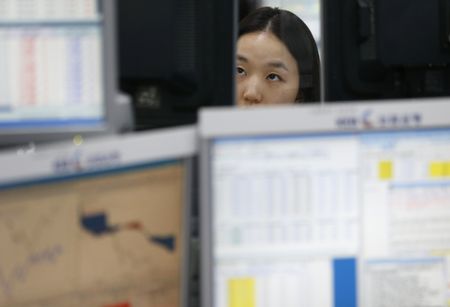By Savyata Mishra
(Reuters) – Investors turned modestly bullish on currencies of South Korea, Malaysia and Thailand, supported by prospects of China’s reopening, a Reuters poll found, while bearish positions on other Asian currencies hovered at multi-month lows amid a weaker greenback.
Market participants turned bullish on the U.S. dollar-sensitive South Korean won for the first time since July 1, 2021, the poll of 12 analysts showed on Thursday.
The fortnightly poll was conducted before U.S. Federal Reserve Chair Jerome Powell signalled slower rate hikes from as soon as December late on Wednesday, following which the safe-haven dollar lost its footing. The dollar index tumbled 5.2% in November, its worst monthly showing since September 2010.
Expectations that the dollar’s strength and U.S. yields had peaked saw investors return to emerging markets in November.
“Given the negative burden of the Fed’s tightening cycle on Asian currencies, an eventual pivot toward easing will likely deliver a rally in Asia FX,” BofA analysts said in a note last week.
Short bets on the Indian rupee were cut to their lowest since mid-April. The currency marked its first monthly gain in November this year, thanks to the easing dollar, ending its longest losing streak in nearly four decades.
“Even as inflation is past its peak, headline and core prints are still elevated, necessitating the Indian central bank to continue with the rate hike cycle,” Radhika Rao, a DBS analyst said in a note.
Risk sentiments in emerging Asia were further boosted by China’s potential pivot from a zero-COVID policy towards reopening, after a string of protests in some cities, as well as support measures for its debt-laden property sector.
“The reopening would boost Korea’s exports due to its high exposure to China, while Thailand would benefit from a return of China tourism inflows in 2H 2023,” BofA analysts said, adding it would aid Malaysia’s export revenues as well.
Bearish bets in China’s yuan, however, fell only marginally, clinging to their lowest levels since April as investor focus was pinned on the implementation of COVID measures and external demand.
Short bets on Indonesia’s rupiah remained firm while those on the Philippines peso were scaled back to their lowest since Feb. 24.
Meanwhile, short positions reversed on the Thai baht to levels last seen in early March while those on the Malaysian ringgit were on the verge of turning bullish.
Political uncertainty subsided in Malaysia after Anwar Ibrahim was sworn in as prime minister last Thursday. However, Barclays analysts warn of challenges from increased fragmentation of domestic politics and the slowing economy.
Bullish views on the Singapore dollar rose slightly, as the region’s best-performing currency so far this year remained supported by its central bank’s targeted monetary policy intervention.
The Asian currency positioning poll is focused on what analysts and fund managers believe are the current market positions in nine Asian emerging market currencies: the Chinese yuan, South Korean won, Singapore dollar, Indonesian rupiah, Taiwanese dollar, Indian rupee, Philippine peso, Malaysian ringgit and the Thai baht.
The poll uses estimates of net long or short positions on a scale of minus 3 to plus 3. A score of plus 3 indicates the market is significantly long the U.S. dollar.
The figures include positions held through non-deliverable forwards (NDFs).
The survey findings are provided below (positions in U.S. dollar versus each currency):
DATE USD/CNY USD/KRW USD/SGD USD/IDR USD/TWD USD/INR USD/MYR USD/PHP USD/THB
1-Dec-22 0.63 -0.15 -0.3 1.08 0.15 0.76 -0.02 0.33 -0.16
17-Nov-22 0.74 0.21 -0.06 1.06 0.84 1.13 1.18 0.89 0.4
03-Nov-22 1.81 1.38 0.47 1.57 1.81 1.47 2.02 1.36 1.34
20-Oct-22 1.96 2.02 1.13 1.83 1.98 1.60 2.33 1.94 2.00
06-Oct-22 1.94 2.25 1.53 1.86 2.12 1.55 2.22 2.16 2.08
22-Sept-22 2.09 2.39 1.61 1.35 2.37 1.23 1.90 1.94 1.86
08-Sept-22 2.04 2.33 1.54 1.13 1.93 1.35 1.89 1.70 1.59
25-Aug-22 1.68 1.85 1.12 1.03 1.53 1.31 1.90 1.38 1.28
11-Aug-22 0.86 1.10 0.51 0.83 1.14 1.00 1.41 0.88 0.87
28-July-22 1.14 1.63 0.92 1.31 1.42 1.62 1.59 1.54 1.89
(Reporting by Savyata Mishra; Editing by Janane Venkatraman)





